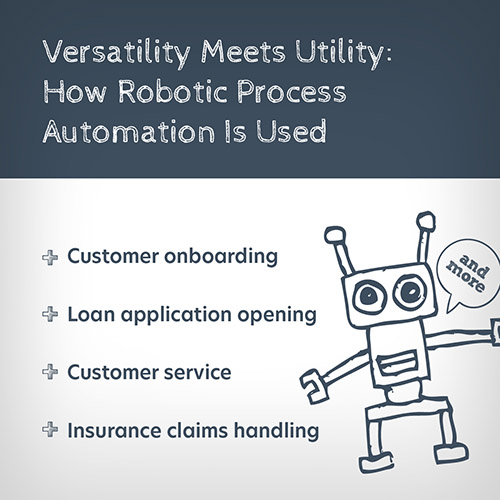Beyond the Hype: Why Robotic Process Automation Works
Blog: Kofax - Smart Process automation
Robotic Process Automation (RPA) is an emerging technology that can help many organizations that still rely on repetitive human effort to complete routine processes. In a typical, manual process, workers copy and paste information from one system to another, and then manually integrate data from multiple sources to leverage it within a process.
In this digital age, why have these processes escaped automation?
Integrating systems is expensive, and poor organizational discipline often surrounds multiple process variations. Plus, the sheer complexity of processes drives many organizations to rely on employees to manually plug process gaps.
Many methods are available for tackling these challenges, and selecting the right automation approach can be quite difficult. Although organizations don’t always have a good feel for what a good end-to-end process should look like, some real “no brainer” process improvements can be implemented quickly using Robotic Process Automation (RPA).
What is RPA?
Unlike physical robots who sit at desks typing and occasionally revolting against their human supervisors, Robotic Process Automation employs software robots, which are better described as integration flows. These robots include powerful, dynamic process flows that provide tangible integration and automation capabilities. They mimic specific actions people take when interacting with web applications, web sites, portals, Excel worksheets, legacy green-screen apps, and email.
Why RPA now?
It took a long time for technology to mature and IT to embrace the idea that a complementary technology can now solve many integration and automation challenges faced by enterprise organizations. Also, although businesses always looked for ways to drive greater efficiencies, roadblocks such as high costs and long development times delayed their implementation. Now organizations are taking a new look at RPA to increase operational efficiency because both IT and business groups can benefit from it.
RPA replaces labor-intensive manual activities
The overarching benefits of robotic process are increased productivity and rapid ROI, powered by non-disruptive integration and rapid implementation.
Here are a few examples of organizations and business activities that can benefit from automation with RPA:
- Financial services and insurance: Pulling data from multiple systems and spreadsheets to generate monthly regulatory compliance reports.
- Accounting and Finance: Collecting invoice and payment information from various systems and initiating credit collection investigation and follow up.
- Healthcare: Verifying a home healthcare patient’s eligibility through online insurance portals.
- Manufacturing: Handling partner purchase orders and invoices coming in through different communication channels.
- Transportation and Logistics: Scheduling shipments and tracking, and updating internal and external (customer) transportation management systems (TMS).
Understanding your RPA business needs and problems you want to solve
Today, the key concept for businesses is to understand where RPA can assist and where it should be joined with other technologies (e.g., BPM/Case Management). There is no simple answer to complex business process problems, and a Band-Aid approach to process improvement can often overshadow the need for process change.
Getting started – key RPA areas and questions to consider
Here are some questions to ask yourself and your team as you consider RPA and how it might benefit your organization.
- Do you need an RPA solution now (not months or years from now)?
- Can you wait for IT to deliver the integration next year?
- Do you have internal and external systems (e.g., websites, portals) that cannot be easily linked other than via a nonintrusive, application UI pathway?
- Does your RPA project only need to be automated for a short period of time, after which you will implement a longer-term solution?
- For various reasons, has your organization not managed to connect modern and legacy systems together due to technical or business hurdles?
- Is process change is required? Is your business group is okay with automating the existing process “as is” without spending the time to design a “to be” process state?
To help answer these questions, and learn more about how RPA works, download this free e-book: Complete the Productivity Puzzle: Guide to Robotic Process Automation. Stay tuned for more news on this powerful, emerging technology.
Leave a Comment
You must be logged in to post a comment.







